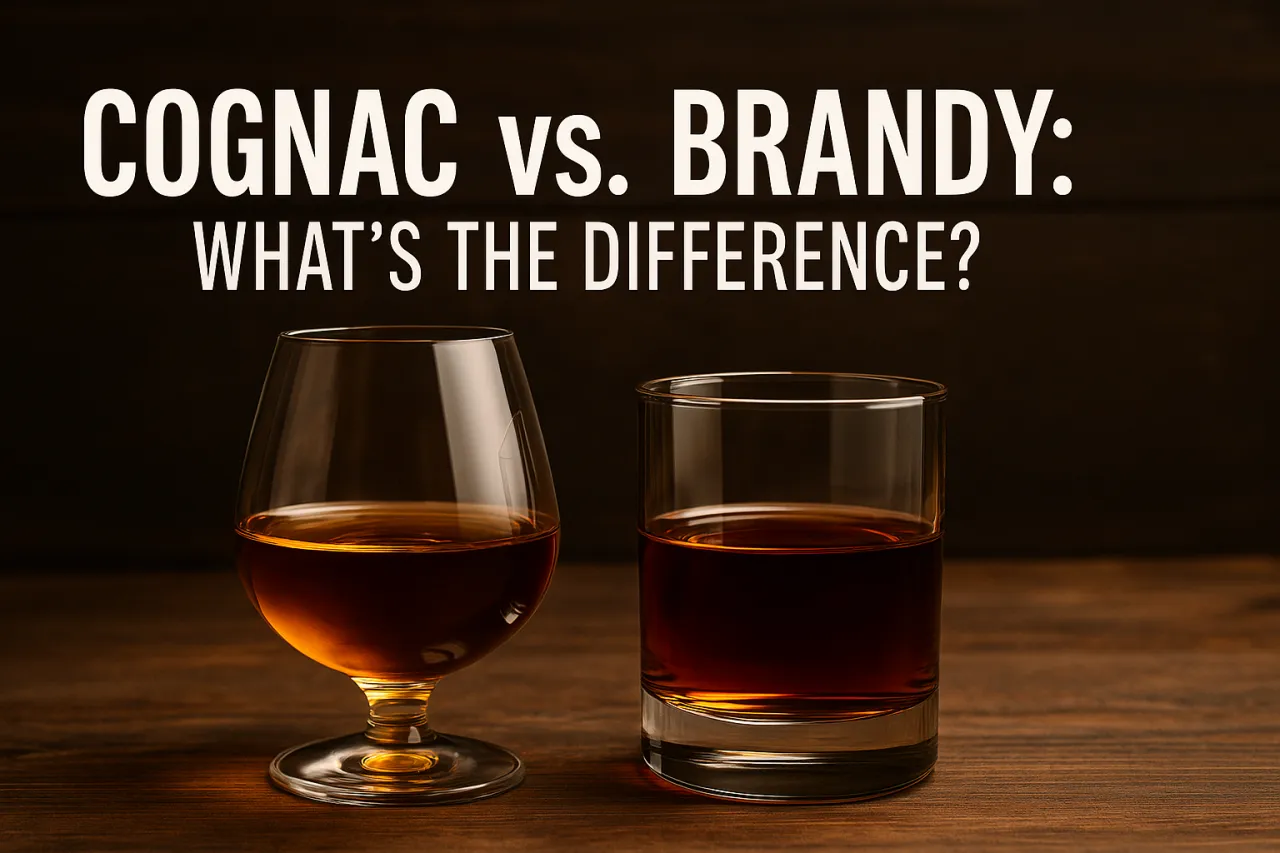Cognac vs. Brandy: What’s the Difference?

By Dave C & Boozeopedia AI Workflow
See how we write our articles
Ever wondered what separates Cognac from Brandy? You’re not alone. These two rich, flavorful spirits often get lumped together—and for good reason. Cognac is a type of brandy, but not all brandy is Cognac. Let’s break it down step by step so you’ll know exactly what makes each unique and when to reach for which bottle.
Step 1: Understand the Basics
Let’s start simple. Brandy is a distilled spirit made from fermented fruit juice—typically grapes, but apples, pears, and other fruits can be used too. Cognac, on the other hand, is a specific kind of brandy that’s made in a very specific way and place.
Think of it like this: Cognac is to brandy what Champagne is to sparkling wine. It’s brandy with a passport and a set of very fancy rules.
Step 2: Location, Location, Location
Cognac isn’t just a fancy label—it’s a protected name under France’s Appellation d'Origine Contrôlée (AOC) system. This designation means Cognac must be produced in a specific geographic region in western France using time-honored techniques. Overseen by the Bureau National Interprofessionnel du Cognac (BNIC), every bottle labeled “Cognac” is subject to strict regulations, from grape variety to aging.
Meanwhile, brandy has no such geographical restrictions. It can be produced anywhere in the world, resulting in a much broader range of styles and influences. You’ll find outstanding brandies from places like Spain, the U.S., South Africa, and beyond.
Why does geography matter? Because it shapes the spirit from the ground up. The local soil, climate, and grape varieties—like the Ugni Blanc used in Cognac—affect the wine’s base quality. Even the oak barrels, often sourced from regional forests, leave their mark on the flavor. The result is a sense of place you can actually taste.
Step 3: Dive into the Production Process
This is where things start to really set Cognac apart.
- Cognac is made from specific grapes—mostly Ugni Blanc—and distilled twice in copper pot stills. It must then age in French oak barrels for at least two years.
- Brandy varies widely. Some use copper stills; others use column stills. Some age in oak; others might not age at all. The rules are more flexible, which means you’ll find a broader spectrum of flavors and styles.
Step 4: Savor the Flavor Differences
Because of its controlled process, Cognac tends to be silky, complex, and layered, with notes of dried fruit, vanilla, spice, and oak. These flavor notes aren't added—they're developed naturally through traditional methods. The Ugni Blanc grapes produce a clean, acidic base wine that's ideal for aging. Double distillation in copper pot stills concentrates the flavors, and extended aging in French oak barrels imparts deep layers of spice, toast, and fruit. Over time, oxidation and interaction with the wood yield the smooth, nuanced character that Cognac is famous for.
Brandy, meanwhile, runs the gamut—from light and fruity to dark and smoky, depending on what it’s made from and how it’s aged.
Quick tip: If you’re looking at Cognac labels, you’ll see terms like:
- VS (Very Special): Aged for at least 2 years in oak casks. Often the youngest and most vibrant style, great for cocktails.
- VSOP (Very Superior Old Pale): Aged for at least 4 years. Offers more complexity and balance, ideal for sipping or elevated mixed drinks.
- XO (Extra Old): Aged for 10 years or more. Rich, deep, and luxurious—the kind of Cognac to savor slowly.
- Napoleon: A label sometimes used for Cognacs aged between 6 and 10 years, bridging the gap between VSOP and XO.
- Extra / Hors d'âge: Ultra-aged Cognacs that often exceed 15 years. These are prestige expressions showcasing the pinnacle of maturation.
Each designation offers clues about the age, depth, and style of the spirit in your glass.
Step 5: Explore How They're Enjoyed
Want to explore Cognac in the broader context of French drinking traditions? Check out our article on French Beverages: A Journey Through Time for a deeper look into how Cognac fits into the country's rich and refined drinking culture.
- Cognac shines on its own or in classic cocktails like the Sidecar or Champs-Élysées Cocktail. It also pairs beautifully with strong cheeses, dark chocolate, or as a luxurious after-dinner sipper.
- Brandy is more of a chameleon. It works in everything from sangrias to warm winter drinks like Hot Toddies. It’s also a go-to in many desserts and sauces, like flambéed dishes or creamy brandy sauces.
The Bottom Line
If you’re after a refined, rule-bound French experience, Cognac is your spirit. But if you’re up for variety and experimentation, brandy opens up a world of possibilities. Either way, both belong on your bar cart.